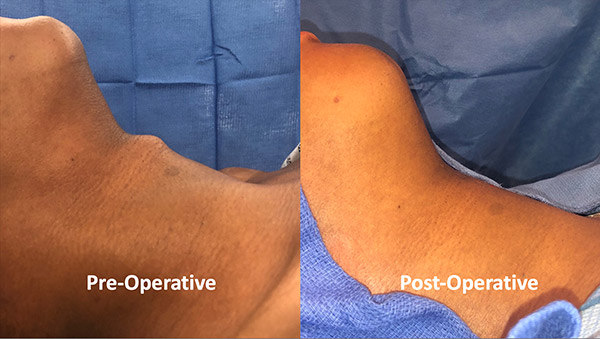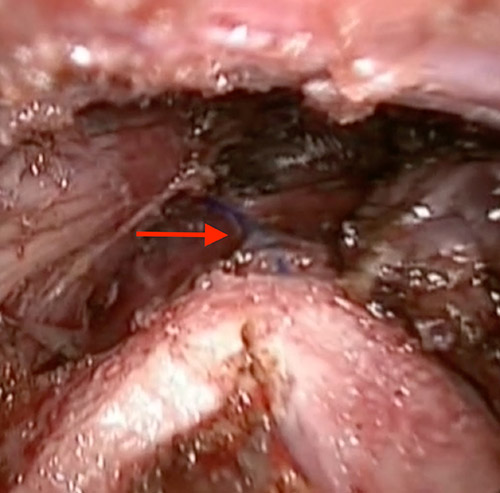Surgeons at NewYork-Presbyterian/
Chondrolaryngoplasty is a surgical approach to minimizing the appearance of the Adams apple by reshaping or shaving down the laryngeal prominence. For years, this procedure has been performed using an open surgical approach, resulting in an external scar in the front of the neck that is not only a cosmetic issue but may "out" transgender individuals by revealing they had the operation. The NewYork-Presbyterian/

Victoria Banuchi, MD
"One of the problems with performing neck surgery is that it is a very visible area of the body. Scars in the neck are not easy to conceal. This becomes not only a cosmetic issue but a health care privacy issue. May patients would rather keep these operations private and avoiding a visible incision is a clever way to do this,” explains NewYork-Presbyterian/
A typically male characteristic of the neck, the laryngeal prominence forms early during puberty. Testosterone has a lengthening effect on the laryngeal cartilage. It is permanent and once it has formed, it cannot be reversed with hormone replacement therapy. "Some of our patients report the laryngeal prominence as playing a major role in their gender dysphoria. Once the prominence is formed it cannot be reshaped by estrogen therapy alone and surgery is therefore the most effective way of reshaping it,” Dr. Banuchi notes. She has been performing endoscopic thyroid surgery for years and refined the technique to spare patients from a visible neck scar. Dr. Banuchi then began to wonder if the surgical technique could be used in other patients having neck surgery. She met Israeli head and neck surgeon Avi Khafif, MD, who had been using the transoral approach for chondrolaryngoplasty in transgender patients. "I knew the approach offered the perfect exposure to this procedure given that the laryngeal prominence if a landmark we almost always encounter during endoscopic thyroid surgery," she says. She started to perform the technique herself with some refinements. Dr. Banuchi worked with NewYork-Presbyterian/

Pre- and post-operative photos of chondrolaryngoplasty demonstrating minimal edema and an adequately feminized laryngeal prominence.
(Image courtesy of The Laryngoscope.)
One of the possible complications of chondrolaryngoplasty is damage to the anterior commissure, where the vocal cords attach into the laryngeal cartilage. If the cords become destabilized, the voice deepens — a side effect that is a problem for transgender women who often engaged in voice therapy for voice feminization. With the approach designed by Drs. Banuchi and Helman, the surgeon places a soft suture at the site of the anterior commissure to act as a guidepost. “The suture tells me where the anterior commissure is so I can take out the cartilage above it. I can’t go beyond it because it will affect the patient’s voice,” explains Dr. Banuchi. The suture is removed at the end of the procedure.
The TOEVA Case Report
Drs. Banuchi and Helman’s patient was a 21-year-old trans woman with gender dysphoria. She had previous facial feminization surgery including rhinoplasty and sliding genioplasty but remained dissatisfied with the appearance of her neck. She had no complications from the TOEVA procedure and was very pleased with her neck appearance after the surgery.

A soft suture placed at the anterior commissure acts as a marker to prevent damage to the vocal cords.
(Image courtesy of The Laryngoscope.)
The operation takes about three hours and is done on an outpatient basis. Patients can generally eat and speak the day after surgery. They will typically have some lower lip swelling. Minor bruising and tenderness along the chin and neck resolve in two to three weeks. Regular activities may be resumed by one week after surgery.
These patients deserve the best care we can give them. If there is a way to feminize the neck to treat gender dysphoria without exchanging the laryngeal prominence for a scar then that’s what we should strive to do.
— Dr. Victoria Banuchi
Insurance coverage varies but generally follows the same requirements as other gender reassignment procedures, such as letters from a psychiatrist and endocrinologist and proof that the patient has been on hormone therapy. They will soon open a prospective clinical trial assessing quality of life and patient outcomes after this procedure and compare those results with the traditional open technique.
With more cases, Dr. Banuchi wonders if the endoscopic chondrolaryngoplasty will eventually replace the open surgical approach. "These patients deserve the best care we can give them. If there is a way to feminize the neck to treat gender dysphoria without exchanging the laryngeal prominence for a scar then that’s what we should strive to do”. "I do several procedures with this approach, and I believe this application has great promise. I am very optimistic that this is worth pursuing."


